Getting From Here to There—Outdoor Recreation Access Routes
Providing accessibility in developed areas requires that people be able to get to features intended for public use. Outdoor recreation access routes are pedestrian routes that allow almost everybody to move around in a recreation area independently. Section 1.2 of FSORAG defines an outdoor recreation access route as "a continuous, unobstructed path designed for pedestrian use that connects constructed features in a campground, camping unit, picnic area, trailhead, or other recreation site where modifications are provided for visitor convenience and comfort." Figure 36 shows an outdoor recreation access route connecting a parking lot and scenic overlook. Section 2.0 of FSORAG contains the technical requirements for outdoor recreation access routes.
Outdoor recreation access routes are not required when camping facilities, picnic facilities, viewing areas, or outdoor constructed features are provided on trails. The routes connecting those facilities are to comply with the technical requirements for trails.
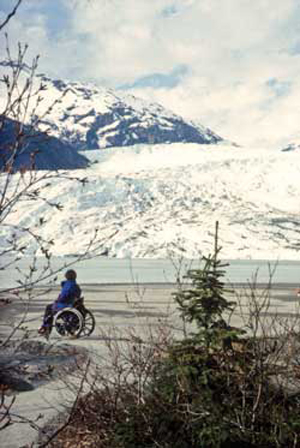
Figure 36—All people must be able to get from the parking area to the viewing area for the Mendenhall Glacier in Alaska; the same is true for other recreation sites in the National Forest System.
Outdoor recreation access routes ensure that visitors can move independently from their car or their camping or picnic spot to the other constructed features provided at a recreation area. When individual elements or constructed features are altered or replaced at existing recreation areas, Forest Service policy requires that they be accessible. However, if the ground under the element isn't changed as part of that renovation or replacement project, this work doesn't trigger the requirement for outdoor recreation access routes.
Design outdoor recreation access routes to meet technical requirements for running and cross slopes, resting intervals, surface, clear tread width, passing spaces, tread obstacles, protruding objects, and openings. If a condition for an exception prevents full compliance with a specific technical requirement on a portion of an outdoor recreation access route that is part of an alteration project, that portion of the outdoor recreation access route only has to comply with the specific technical requirements to the extent practicable. This deviation is not allowed for new construction; outdoor recreation access routes are required. When planning for a new outdoor recreation area or viewing area, the natural terrain and the general accessibility of the natural environment should be part of the site selection criteria.
Because individuals usually arrive at recreational vehicle (RV) dump stations by vehicle, there is an exception to the outdoor recreation access route connection requirement. A connecting outdoor recreation access route isn't required if an accessible vehicle pullup [sic] space is provided at the RV dump station.
The outdoor recreation access route may be provided within a roadway if the roadway is the only general circulation path for pedestrians at a recreation site. The outdoor recreation access route in the roadway isn't required to comply with outdoor recreation access route technical requirements for grade, resting, or passing intervals, but clear passage of 32 inches is required around or through speed restriction devices, gates, or other barriers.
Surfaces for Outdoor Recreation Access Routes
The surface of an outdoor recreation access route and the surface surrounding constructed features must be firm and stable. No exceptions are allowed. Slip resistance is not required because leaves and needles, dirt, ice, snow, and other surface debris and weather conditions are components of the natural environment and would be difficult, if not impossible, to avoid.
-
A firm surface resists deformation by indentations.
-
A stable surface is not permanently affected by expected weather conditions and can sustain normal wear and tear from the expected use(s) of the area between planned maintenance cycles.
Firm and stable surfaces prevent assistive devices from sinking into the surface. Surfaces that are not firm and stable make travel difficult for a person using crutches, a cane, a wheelchair, or other assistive device. In the accessibility guidelines, the standard assistive device is the wheelchair because its dimensions, multiple moving surface contact points and four wheels often are difficult to accommodate. If a person using a wheelchair can use an area, most other people also can use that area.
During the planning process, potential surface materials should be evaluated for noticeable distortion or compression during the season(s) of managed use and for stability under normal weather conditions and expected uses. If the surface won't remain firm and stable, another surface material should be used.
If the natural soils won't provide a firm and stable surface, soil stabilizer or artificial surfacing will be needed. The Forest Service technology and development report, "Soil Stabilizers on Universally Accessible Trails," contains information about the effectiveness of soil stabilizers. It is available at http://www.fs.fed.us/eng/pubs/pdf/00231202.pdf or http://www.fhwa.dot.gov/environment/fspubs/00231202/.
Design Tip
Use a rule of thumb to estimate firmness and stability.
What sort of surface is firm and stable? If the answer to both of the following questions is yes, the surface is probably firm and stable.
Could a person ride a narrow-tired bicycle across the surface easily without making imprints? (Bicycle tires are similar to the large rear wheels of a wheelchair.)
Could a folding stroller with small, narrow plastic wheels containing a 3-year-old be pushed easily across the surface without making imprints? (A stroller's wheels are similar to the front wheels of a wheelchair.)
While this method for determining firmness and stability isn't scientifically accurate, it has proven to be effective.
Design Tip
Provide appropriate walking surfaces for the setting.
A firm and stable surface does not always mean concrete and asphalt. The provision states that surface material should be appropriate to the setting and level of development. Some natural soils can be compacted so they are firm and stable. Other soils can be treated with stabilizers without drastically changing their appearance. Many surface materials that appear natural and that meet the firm and stable requirements also are available on the market. Investigate these options and use surface materials that are consistent with the site's level of development and that require as little maintenance as possible.
Construction Tip
Use better surface materials.
Generally, the following materials are more likely to provide firm and stable surfaces:
-
Crushed rock (rather than uncrushed gravel)
-
Rock with broken faces (rather than rounded rocks)
-
A rock mixture containing a full spectrum of sieve sizes, including fine material (rather than a single size)
-
Hard rock (rather than soft rock that breaks down easily)
-
Rock that passes through a ½-inch (13-millimeter) screen (rather than larger rocks)
-
Rock material that has been compacted into 3- to 4-inch (75- to 100-millimeter) -thick layers (rather than thicker layers)
-
Material that is moist (not soggy) before it is compacted (rather than material that is compacted when it is dry)
-
Material that is compacted with a vibrating plate compactor, roller, or by hand tamping (rather than material that is laid loose and compacted by use)
Slopes and Resting Intervals for Outdoor Recreation Access Routes
Running slope is the lengthwise slope of an outdoor recreation access route, parallel to the direction of travel. Outdoor recreation access route sections of any length may have a running slope ratio of up to 1:20, a 5-percent grade (figure 37). Steeper terrain may make this difficult to achieve. Many visitors can negotiate steeper slopes for short distances, so short segments of outdoor recreation access routes may be steeper, as shown in table 2, but the slope of an outdoor recreation access route may never exceed 1:10, a 10-percent grade. In this guidebook, the terms running slope and grade often are used interchangeably.
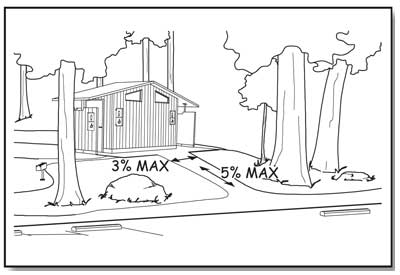
Figure 37—The basic slope requirements for outdoor recreation access routes and beach access routes.
Cross slopes—the side-to-side slope of an outdoor recreation access route—must not exceed 1:33 (3 percent), as shown by figure 37. However, if the surface of the outdoor recreation access route is paved or built with boards, the cross slope must not be steeper than 1:48 (2 percent).
Design Tip
The cross slope requirement depends on what material is used.
Those who use a mobility device know that as cross slope increases, travel becomes more difficult. This is because working against the sideways pull of the cross slope can double the effort needed to make forward progress. However, in an outdoor environment, the cross slope has to be steep enough that water won't accumulate on the travel surface. While slope and drainage can be precisely controlled on surfaces that are paved (asphalt, concrete, paving blocks, and so forth) or built with boards (wood planks, heavy timber, concrete, fiberglass, or other manufactured material), it's more difficult to ensure drainage on natural or gravel surfaces. When water accumulates on natural or gravel surfaces, they often become muddy and impassible. That's why the cross slope is allowed to be steeper on natural or gravel surfaces than on surfaces that are paved or built with boards.
Resting intervals are relatively level areas that provide an opportunity for people to catch their breath before continuing along the outdoor recreation access route. These intervals are required between each outdoor recreation access route segment any time the running slope ratio exceeds 1:20 (5 percent) as shown on table 2. A resting interval must be at least 60 inches (1,525 millimeters) long and at least as wide as the widest segment of the outdoor recreation access route leading into it, if the resting interval is within the outdoor recreation access route. If the resting interval is beside the outdoor recreation access route, it has to be at least 60 inches (1,525 millimeters) long and at least 36 inches (915 millimeters) wide. Depending on the design and location, the intersection of two outdoor recreation access routes may act as a resting interval.
| Runnign [sic] Slopes on ORARs | Maximum Length of Segment Between Resting Intervals | |
|---|---|---|
| Steeper than | But not Steeper than | |
| 1:20 (5 percent) | 1:12 (8.33 percent) | 50 feet (15 meters) |
| 1:12 (8.33 percent) | 1:10 (10 percent) | 30 feet (9 meters) |
Construction Tip
Slope and grade terminology.
Slopes are often described as a ratio of vertical distance to horizontal distance, or rise to run. For instance, a slope ratio of 1:20 means that for every 1 foot of vertical rise, there are 20 feet of horizontal distance; for every meter of vertical rise, there are 20 meters of horizontal distance (figure 38). When the slope ratio is stated as a percent, it is referred to as the grade. A 1:20 slope stated as a percent would be a 5 percent grade.
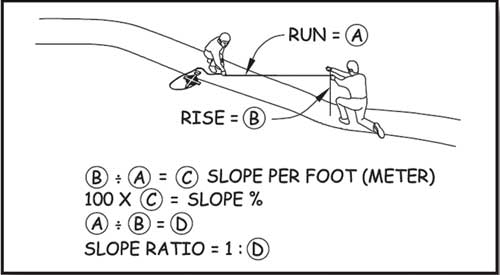
Figure 38—Determining the slope ratio.
The slopes of a resting interval may not exceed a ratio of 1:33 (3 percent) in any direction (figure 39). However, if the surface is paved or is built with boards, the slope can't be steeper than 1:48 (2 percent) in any direction.
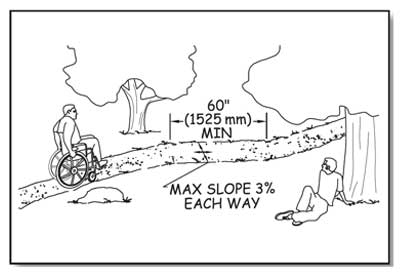
Figure 39—The basic resting interval requirements for outdoor recreation access routes.
Grade requirements for an outdoor recreation access route may be more difficult to meet when altering an existing site than during new construction. Accessibility was seldom considered when older recreation sites were designed. Many campgrounds and picnic areas were located in spectacularly scenic settings, but on steep terrain. Complying with the grade requirement in these areas may be difficult without a fundamental change to the recreation environment. A deviation is allowed for alteration projects where a condition for an exception exists.
In alterations only, if a condition for an exception prevents full compliance with a specific technical requirement on a portion of an outdoor recreation access route at camping and picnic facilities and at trailheads, that portion of the outdoor recreation access route is required to comply with the specific technical requirement only to the extent practicable.
This deviation from the technical requirement is not allowed to be used for new construction at camping and picnic facilities or at trailheads. When planning for a new outdoor recreation area, the natural terrain and the general accessibility of the natural environment should be part of the site selection criteria because compliance with outdoor recreation access route requirements is required for new construction.
Clear Tread Width and Passing Spaces for Outdoor Recreation Access Routes
Clear tread width means the width of the traveled surface on the ground and also above the ground between obstacles (figure 40). The minimum clear tread width of an outdoor recreation access route is 36 inches (915 millimeters), which is wide enough to allow unobstructed passage by a wheelchair. When a condition for an exception exists, such as where an outdoor recreation access route must be routed between two large boulders that can't be removed, then the clear tread width may be reduced to not less than 32 inches (815 millimeters) or the maximum width that can be achieved.
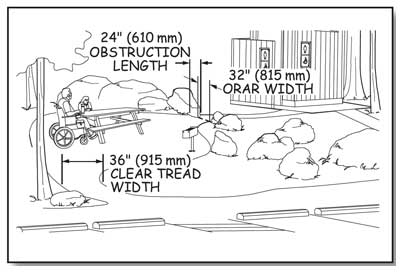
Figure 40—The clear tread width is the unobstructed width of the traveling surface.
All outdoor recreation access routes in a recreation site don't necessarily have to be the same width. Consider the number of people who will use the route at the same time and how they will want to use it—single file or walking and talking side by side—and design accordingly. For example, a 60-inch (1,525-millimeter) -wide main route may be designed to connect a group of campsites to important constructed features, such as a rustic outdoor amphitheater, toilet buildings, or water hydrants. Secondary routes, such as a spur from the main route to a quiet, intimate path along a stream, may be only 36 inches (915 millimeters) wide.
Two people using wheelchairs need a 60-inch (1,525-millimeter) -clear tread width to pass comfortably and safely on an outdoor recreation access route. However, this width isn't always appropriate or required. Where the clear tread width of a route is less than 60 inches (1,525 millimeters), passing spaces are required at least every 200 feet (61 meters). Passing spaces must be at least 60 inches (1,525 millimeters) wide (including the route width) by 60 inches (1,525 millimeters) long (figure 41).
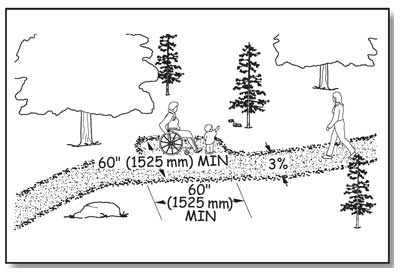
Figure 41—Minimum required dimensions for a passing space for an outdoor recreation access route or a beach access route.
Another option allows a T-intersection of two outdoor recreation access routes or other walking surfaces to be a passing space (figure 42) provided that the arms and stem of the T-shaped space extend at least 48 inches (1,220 millimeters) beyond the intersection. Either configuration would provide enough room for a person to move to the side and let an oncoming person pass along the route. The cross slope of a passing space must not exceed 1:33 (3 percent). Where the surface is paved or is built with boards, the slope must not be steeper than 1:48 (2 percent) in any direction.
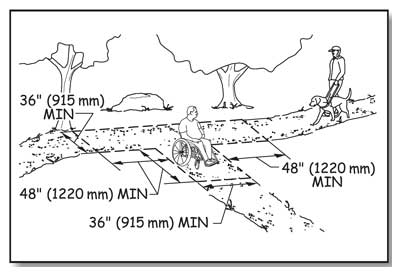
Figure 42—A T-intersection may be used as a passing space on an outdoor recreation access route or a beach access route if it has dimensions as shown, or larger.
Design Tip
Access route width may vary.
The 36-inch (915-millimeter) minimum clear tread width is just that—a minimum. To determine how wide the outdoor recreation access routes in a project should be, look at the level of development of the site and how the site will be used. In a more highly developed area, a 48- or 60-inch (1,220- or 1,525-millimeter) -wide route may be appropriate, while a 36-inch (915-millimeter) -wide tread may be a better fit in a less developed site.
Tread Obstacles on Outdoor Recreation Access Routes
A tread obstacle is anything that interrupts the evenness of the tread surface. On outdoor recreation access routes, an obstacle may occur where a tree root or rock protrudes above the surface or where two different surfaces abut, such as when a concrete path joins an asphalt path. If they are pronounced, tread obstacles can pose a serious tripping hazard. Where tread obstacles exist along an outdoor recreation access route, they must not be more than 1 inch (25 millimeters) high. Where the surface is paved or is built with boards, obstacles must not be more than ½ inch (13 millimeters) high.
Design Tip
Avoid the use of stairs on outdoor recreation access routes.
In new construction, stairs aren't allowed on outdoor recreation access routes except at viewing areas where there is a condition for an exception. For new recreation sites, select locations that will not require the use of stairs.
Avoid the use of outdoor stairs wherever possible. Sometimes, an alteration project at an existing recreation site includes an area where stairs can't be avoided. When stairs are unavoidable, they should generally meet the requirements for stairs in Architectural Barriers Act Accessibility Standards. Although these requirements are not mandatory for stairs that aren't part of a means of egress for a building, compliance will ensure the stairs are safe and comfortable to use.
The accessibility guidelines for outdoor recreation areas do not require handrails for stairs. Consider the safety of the people using the stairs and the setting when deciding whether handrails are appropriate. What is the expected amount of use? How can the appearance of overdevelopment be avoided while providing for safe use of the stairs? When deciding whether handrails are necessary on outdoor stairs, also consider how many should be provided. For example, a few steps at an individual campsite may not need a handrail. Where a handrail would be helpful, one handrail in the center may accommodate low-volume, two-way traffic. Treads that are just wide enough for one-way traffic could have a handrail on one side. Two handrails may be needed if stairs are provided in hightraffic areas.
Openings in Outdoor Recreation Access Route Surfaces
Openings are gaps in the surface of an outdoor recreation access route. Gaps include spaces between the planks on a boardwalk or in a drainage grate. Openings that are big enough to allow wheels, cane or crutch tips, or shoe heels to drop through or get stuck are hazards that shouldn't occur in pedestrian routes (figure 43). Openings up to a half of an inch (13 millimeters) wide are permitted. Place elongated openings that are more than a quarter of an inch wide with the long dimension perpendicular or diagonal to the primary direction of travel (figure 44).
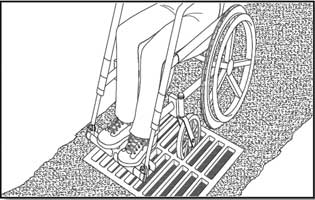
Figure 43—Big openings in outdoor recreation access route surfaces create problems.
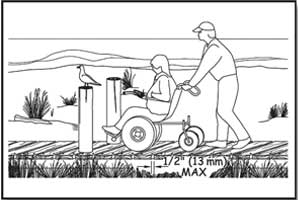
Figure 44—Elongated openings must be perpendicular to the direction of travel.
Protruding Objects and Outdoor Recreation Access Routes
Objects that extend into the travel way of an outdoor recreation access route from the side or from overhead can be hazardous to people who are paying more attention to their companions than the travel route, as well as to people who are blind or have low vision. Protruding objects are defined as constructed features (such as signs) that extend into the clear width area of an outdoor recreation access route, resting interval, or passing space and that are between 27 inches (685 millimeters) and 80 inches (2,030 millimeters) above the travel surface. Do not allow constructed features to extend into the clear width area more than 4 inches (100 millimeters, figure 45).
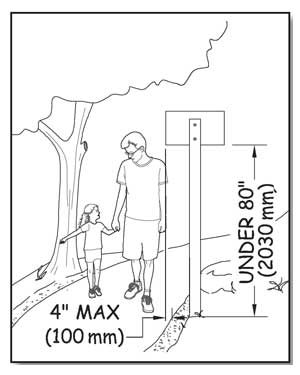
Figure 45—Constructed features can't extend into the clear width area more than 4 inches if they are between 27 and 80 inches (685 to 2,030 millimeters) above the walking surface.
Accessibility guidelines do not consider natural elements (such as tree branches and rock formations) to be protruding objects. Provide and maintain clearance from natural elements around outdoor recreation access routes in accordance with your unit's standards, keeping in mind overhanging hazards to people who are blind or have low vision, or are not focused on the route ahead.
Design Tip
Edge protection may be used for outdoor recreation access routes.
Edge protection is a raised curb, wall, railing, or other structure that defines the edge of a travel surface and may help keep people on the travel surface. Edge protection is not required for accessibility on outdoor recreation access routes, and it is not usually desirable in outdoor environments because it isn't as easy to see or detect objects near the ground. However, edge protection may be desirable for safety or other reasons. Edge protection curbs (figure 46) in an outdoor environment are required to be at least 3 inches (75 millimeters) high.
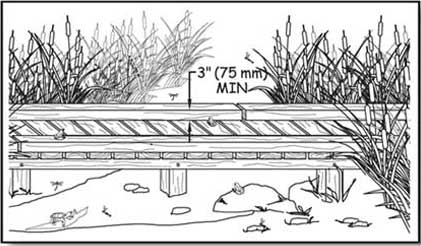
Figure 46—Edge protection is optional on an outdoor recreation access route, but if present, edge protection must be at least 3 inches high.
Gates and Barriers
If gates or barriers are constructed to control access to outdoor recreation access routes, beach access routes, or trails, include openings wide enough to allow hiker passage (figures 47 and 48) that complies with ODAAG, section 1017.3 Clear Tread Width. That section requires 36 inches (915 millimeters) of clear width. However there may be areas where Condition for an Exception 3 applies (for instance, where providing a 36-inch-wide opening would allow the entrance of motorized vehicles that are not permitted behind the barrier). In such circumstances, 32 inches (815 millimeters) clearance, the same as is required for an interior door, will provide pedestrian access to the recreation opportunity without permitting motorized access behind the gate or barrier. Be sure to document all exceptions. If there is a gate, measure the clear opening width with the gate open 90 degrees. As required in ABAAS, section 307.2, do not allow projections into the clear opening width between the trail surface and 27 inches (685 millimeters) above the trail surface. Projections of more than 4 inches (100 millimeters) aren't allowed between 27 inches (665 millimeters) and 80 inches (2,030 millimeters) above the trail surface. ABAAS, section 404.2.3 also contains allowances for projections of closers and stops that aren't likely to apply to trail barriers or gates. Examples of blockage by and passage around barriers are shown in figures 21 and 22. The clear opening width is the key. The travel surface must meet the same requirements as the adjacent outdoor recreation access route, beach access route, or trail.
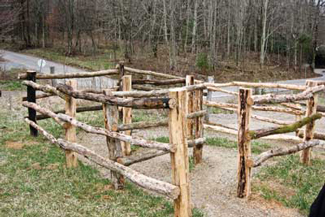
Figure 47—The winding configuration of this rustic chicane where the Appalachian Trail crosses Tennessee Highway 91 and the Osborne farm allows pedestrians to pass through the fence to use the trail but keeps motorized users out and horses inside the farm fence.
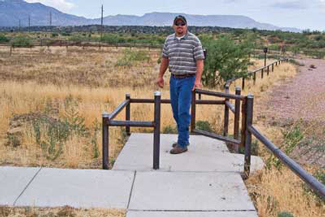
Figure 48—A steel kissing gate on the Prescott National Forest prevents passage by motor vehicles. The design balances the principles of the Built Environment Image Guide with the needs for access control. Sturdy, vandal-resistant materials were needed to discourage determined off-road vehicle users.
Gate hardware must comply with ABAAS, section 404.2.7. This section refers to the requirement in ABAAS, section 309, that controls and operating mechanisms have to be operable with one hand without tight grasping, pinching, or wrist twisting, using a force no greater than 5 pounds (2.2 newtons), as explained in "Reach Ranges and Operability Requirements." It also requires that operable parts of latches must be located between 34 inches (865 millimeters) and 48 inches (1,220 millimeters) above the trail surface. The operating hardware for sliding gates must be exposed and usable from both sides. In alterations, a projection of five-eighths of an inch (16 millimeters) into the clear width is allowed for the gate latch stop.
Designs for several accessible gates (figure 49) are available in the Forest Service publication "Accessible Gates for Trails and Roads" at http://fsweb.mtdc.wo.fs.fed.us/php/library_card.php?p_num=0623%202340. The publication includes drawings for gates that can be used to close roads and trails to motor vehicle access while still providing providing 36-inch-wide (915-millimeters-wide) passage for pedestrians and devices that meet the definition of a wheelchair (see figures 6 through 11), as well as other gate designs that allow pedestrian and equestrian passage while prohibiting motor vehicle access.
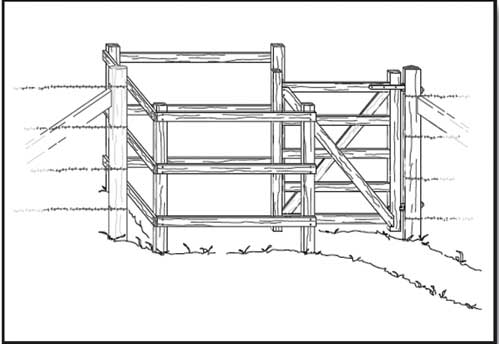
Figure 49—This timber kissing gate is one of the designs available in the Forest Service publication Accessible Gates for Trails and Roads.

User Comments/Questions
Add Comment/Question